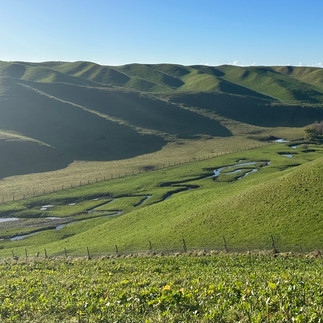TUKITUKI FARMER FOCUS - Grant and Sally Charteris
- Holly Ormond
- Jul 19, 2023
- 4 min read

Tukituki Land Care is celebrating all the great work being done by local farmers in the Tukituki sub-catchments. They met with Grant Charteris, a Tikokino deer farmer with a passion for on-farm environmental enhancement.
Grant and Sally Charteris farm Forest Road Farm, a 330 ha red deer stud and velvet operation in Tikokino. Whilst deer are at the heart of everything they do, their passion for environmental enhancement is a driving force behind their extensive fencing and planting projects. They are previous winners of the Hawke’s Bay Farmer of the Year and the Elworthy Award; the premier environmental accolade for deer farming in New Zealand.
The farm is located at the top of the Mangaonuku Stream and backs onto Gwavas Forest and the eastern edge of the Ruahine Range. It is rolling to steep hill country with three leading ridges and gullies. Along with red deer, they also run Hereford cattle and 200 shedding Wiltshire sheep.
When Grant’s grandmother bought the land in 1956, it was just four paddocks of Gwavas Station. His father took over in 1976 with a passion for deer farming and when Grant took the reins in 2001, he took the deer farm to stud level.
Grant and Sally started fencing and planting on the farm twenty years ago, but more recently have focused on native planting and they have now planted over 25,000 plants and trees. “We originally started planting for practical reasons; to stop the deer congregating in and degrading one particular area”, says Grant. “But then I got a lot of pride in the enhancement and it morphed into our business plan, especially for the stud side of it”.
Whilst the majority of the plants were planted using a planting crew, Grant and Sally have also used it as a learning opportunity for their children and children from nearby Tikokino School who helped plant and protect over 2000 natives plants around their farm.
In 2017, they put in a new water system with bore water, allowing them to fence off their water sources. Gullies and stream banks have now been fenced and planted, leaving buffer strips of non-cultivated land to reduce soil erosion and to minimise sediment run-off. Grant is also careful not to run cattle and deer at high stocking rates near flowing creeks if they are not fenced off.
“It is a matter of figuring out what is important for stock flow as well as the environmental enhancement. It still has to work practically as a farm”, says Grant. “Deer like to interact with each other on the fence line. If you put a fence up and plant there, all of a sudden they have no need to run the fence line and that stops the environmental damage”.
We farm the animals to their environment, not the other way around”, says Grant. “We don’t break feed the deer on the crops, they feed ad-lib and are free to do what they want with no wires”. They are social animals and at this time of year they are getting over the roar and like their own space, so if you confine them to an area it not only causes social pressure that can lead to degradation of the land, it also means that I’m not getting the desired production benefits that I need to produce the highest quality products that we strive for”.
Forest Road Farm has not escaped the harsh environmental challenges faced by many Hawke’s Bay farmers. Many plants were lost in the 2020 drought and Cyclone Gabrielle brought the first ever slips on the farm along with 600 meters of lost fencing. “The amount of water for a catchment that starts on the farm, or just above it in places, was huge. Areas that were two foot high all the way along in watercress and carexes were completely cleaned out”.
Grant and Sally are not done with their planting projects. “Once we link up two large areas of planting we will have two whole valleys done on the farm”, says Grant. “Imagine what it will look like in ten years time”. Grant and Sally have also fenced off another large area on their land. Now that they have it at a compliance stage, they can see the potential for a large environmental project. “We would love to put in something like a three-tier dam system and plant it up, which would allow for water filtration and biodiversity and also mean sediment could be trapped. Gabrielle has shown us how much sediment and gravel moves in these large weather events, and also taught us that we need to be able to maintain them on an ongoing basis. We would need to have adequate access into the area to clean sediment out for long term sustainability”, says Grant who is looking into what funding is currently available for a project of this kind. “It is a big area though, and we really need a sensible outcome that will not send you broke by doing it”.
Grant and Sally’s children have been a driving force behind many of the decisions made. “We want to create a platform where the next generation can grow and produce whatever products and market them however they want to, wherever in the world”, says Grant. “That is the ethos behind it”.




























Comments